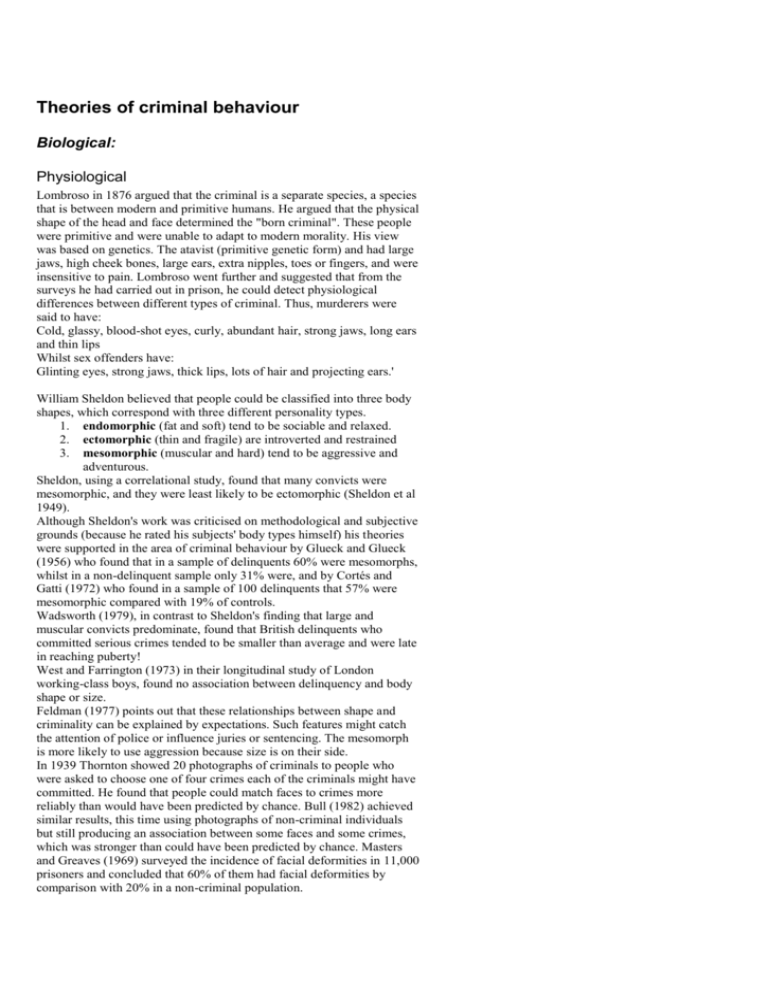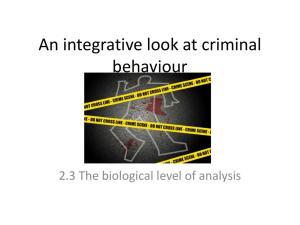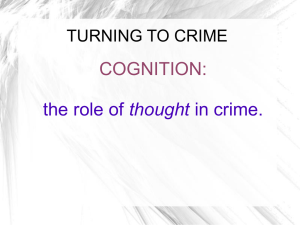theories detail
advertisement

Theories of criminal behaviour
Biological:
Physiological
Lombroso in 1876 argued that the criminal is a separate species, a species
that is between modern and primitive humans. He argued that the physical
shape of the head and face determined the "born criminal". These people
were primitive and were unable to adapt to modern morality. His view
was based on genetics. The atavist (primitive genetic form) and had large
jaws, high cheek bones, large ears, extra nipples, toes or fingers, and were
insensitive to pain. Lombroso went further and suggested that from the
surveys he had carried out in prison, he could detect physiological
differences between different types of criminal. Thus, murderers were
said to have:
Cold, glassy, blood-shot eyes, curly, abundant hair, strong jaws, long ears
and thin lips
Whilst sex offenders have:
Glinting eyes, strong jaws, thick lips, lots of hair and projecting ears.'
William Sheldon believed that people could be classified into three body
shapes, which correspond with three different personality types.
1. endomorphic (fat and soft) tend to be sociable and relaxed.
2. ectomorphic (thin and fragile) are introverted and restrained
3. mesomorphic (muscular and hard) tend to be aggressive and
adventurous.
Sheldon, using a correlational study, found that many convicts were
mesomorphic, and they were least likely to be ectomorphic (Sheldon et al
1949).
Although Sheldon's work was criticised on methodological and subjective
grounds (because he rated his subjects' body types himself) his theories
were supported in the area of criminal behaviour by Glueck and Glueck
(1956) who found that in a sample of delinquents 60% were mesomorphs,
whilst in a non-delinquent sample only 31% were, and by Cortés and
Gatti (1972) who found in a sample of 100 delinquents that 57% were
mesomorphic compared with 19% of controls.
Wadsworth (1979), in contrast to Sheldon's finding that large and
muscular convicts predominate, found that British delinquents who
committed serious crimes tended to be smaller than average and were late
in reaching puberty!
West and Farrington (1973) in their longitudinal study of London
working-class boys, found no association between delinquency and body
shape or size.
Feldman (1977) points out that these relationships between shape and
criminality can be explained by expectations. Such features might catch
the attention of police or influence juries or sentencing. The mesomorph
is more likely to use aggression because size is on their side.
In 1939 Thornton showed 20 photographs of criminals to people who
were asked to choose one of four crimes each of the criminals might have
committed. He found that people could match faces to crimes more
reliably than would have been predicted by chance. Bull (1982) achieved
similar results, this time using photographs of non-criminal individuals
but still producing an association between some faces and some crimes,
which was stronger than could have been predicted by chance. Masters
and Greaves (1969) surveyed the incidence of facial deformities in 11,000
prisoners and concluded that 60% of them had facial deformities by
comparison with 20% in a non-criminal population.
Genetic
Jacobs et al (1965) suggested that men with the XYY syndrome were
more aggressive than normal 'XY' men. XYY men are over-represented in
the prison population. There are 15 sufferers per 1,000 in prisons and 1
per 1000 in the general population.
XYY men have lower intelligence and it could be this that leads to
aggression.
A Danish study, which screened 4591 men for the presence of XYY,
found only 12 cases (Witkin et al., 1976). Whilst these individuals were
indeed more likely to be involved in crime than chance would have
predicted (41.7% of them, by comparison with 9.3% of the XY
individuals), it was not involvement in violent crime. Their conclusion
was that the over-representation of XYY males in prisons and special
hospitals was more likely to be the result of other characteristics - low
intelligence and above-average height - and the social reaction that these
characteristics may have produced.
Neurophysiological
Raine 1994 used PET scans to study the living brains of impulsive killers.
Damage was found in the pre-frontal cortex, which controls impulsive
behaviour. The task used involved sustained attention. It involved
watching a screen for 32 minutes and responding every time a 0 appeared.
Impulsive individuals also missed many of the 0s. Oddly enough, prefrontal under arousal has also been found in politicians!
ADHD
Another suggestion is that certain individuals, as a result of genetic
predisposition or brain damage at birth, suffer from a cluster of symptoms
which render them incapable of moral control and because of cortical
underarousal, they are constantly seeking stimulation. The symptoms
appear in early childhood and are subsumed in the term attention deficit
hyperactivity disorder (ADHD). They include inappropriate degrees of
inattention, impulsiveness, challenging behaviour and hyperactivity. The
symptom cluster is also known as MBD or minimal brain dysfunction.
Moir and Jessel (1995) have suggested that this brain dysfunction can
account for impulsive and seemingly irrational crimes, some of which
involve violence. Moreover, they suggest that brain scans could identify
the disorder in young children who are already showing behavioural
problems and that treatment (Ritalin (a stimulant), biofeedback and
parental training) could possibly prevent these children growing up to be
seriously antisocial.
Neurochemical
The brain’s chemistry can be influenced by diet, for example, food
additives, pollution or hypoglycaemia (low blood sugar levels associated
with forms of diabetes). Dawn Stanton attacked her husband with a knife
when hypoglycaemic. But not all diabetics without insulin act criminally.
David Garabedian worked with strong pesticides and attacked and killed a
woman where he was working. He was a quiet man who changed after the
influence of the chemicals. The reason for the change was an increase in
acytecholine in the hypothalamus. Brain chemistry in itself is not a
sufficient explanation to account for all types of criminal behaviour.
Individuals who take large amounts of steroids can become extremely
violent (known as "roid rage"). Steroids, usually taken to increase muscle
growth, also increase testosterone levels. Horace Williams, a body
builder, beat a man to death after taking two thousand times the
recommended dosage of steroids.
Family studies:
Can be used for Nature vs. nurture evaluation so
provides both biological and environmental support.
The Cambridge Study: problem families produce
problem children
Farrington, D.P. (1996) The Development of Offending and Antisocial
Behaviour
from Childhood to Adulthood. In Cordella, P & Siegel, L. (eds) Readings
in Contemporary Criminological Theory. Boston: Northeast University
Press.
Aim: To describe the development of delinquent and criminal behaviour
in inner city males, to investigate how far it could be predicted in
advance, and to explain why juvenile delinquency began. The original
study was begun in 1961—62: this is a follow-up study of 411 London
boys, born mostly in 1953.
Method:
Design: This is a longitudinal study based on interviews and tests
conducted at various ages over, to date, 24 years.
Participants: The great majority of the sample was chosen by taking all
the boys who were then 8—9 years old and on the registers of six state
primary schools in one location in London. The boys were almost all
white and predominantly from working-class families.
Measures used:
1 Tests and interviews at school at ages 8, 10 and 14 years. Interviews in
the research office at about 16, 18 and 21 and in homes at about 25 and
31. The tests in schools measured intelligence, attainment, personality and
psychomotor skills. The interviews collected infor-mation concerning
employment history, relationships with females, leisure activities such as
drinking and fighting, and offending behaviour.
2 interviews with the parents about once a year from when the study
began (when the boys were about 8) to when they were 14 or 15 years
old, It was mainly the mothers who were interviewed. The parents
provided information on family size, employment history, childrearing
practices, degree of supervision and whether there had been any
temporary separations.
3 Questionnaires completed by the boys’ teachers when the boys were 8,
10, 12 and 14. These concerned troublesome and aggressive behaviour,
attainment, and truancy. Peers provided information on popularity,
daring, dishonesty and troublesomeness.
4 Records From the Criminal Record Office to gain information on
convictions of the boys, their parents, their siblings and, later, their wives
or cohabitees. Minor offences such as common assault, traffic offences
and drunkenness were not included in these statistics.
Results:
Statistics on crimes committed:
1 By the age of 32, 37 per cent of the males had committed criminal
offences. The peak age was 17. Nearly three quarters of those convicted
as juveniles were reconvicted between the ages of 17 and 24, and nearly
half of the juvenile offenders were reconvicted between the ages of 25
and 32.
2 Offending was very much concentrated in families. Just 4 per cent of
the 400 families accounted for 50 per cent of all convictions of all family
members.
3 The worst offenders tended to be from large-sized, multi-problem
families.
4 Most juvenile and young adult offences occurred with other people, but
this co-offending declined with age. Co-offending with brothers was not
uncommon when the siblings were close in age but co-offending with
fathers (or mothers) was very rare.
5 The most common crimes in late teens were burglary, shoplifting, theft
of and from vehicles, and vandalism. All of these declined in the twenties,
but theft from work increased,
6 Self reports showed that 96 per cent of the males had committed at least
one crime that might have led to conviction, so criminal behaviour was
not deviant.
Predictors of crime at age 8—10:
1 Antisocial child behaviour including troublesomeness, dishonesty and
aggression.
2 Hyperactivity-impulsivity-attention deficit.
3 Low intelligence and poor school attainment.
4 Family criminality.
5 Family poverty, including low family income, large family size and
poor housing.
6 Poor parental child-rearing techniques, poor supervision, parental
conflict and separation from parents.
Conclusion: Any one of these factors independently predicts offending
and the following suggestions are made as to the reasons for this.
Children from poorer families are more likely to offend because, due to
poor school attainment and an inability to manipulate abstract concepts,
they are less able to achieve their goals legally. Impulsive children cannot
see the consequences of their actions and desire immediate gratification.
Children who are exposed to poor child-rearing practices, conflict or
separation do not build up inhibitions against antisocial behaviour. Lastly,
children from criminal families and those with delinquent friends develop
anti-establishment attitudes and the belief that it is justifiable to offend.
This research demonstrates that problem children grow into problem
adults who in turn produce problem children. Sooner or later serious
measures must be taken to break this cycle.
Twin studies and adoption studies
An 'MZ apart' study is when two monozygotic children have been brought
up apart. If both turn out to be criminals then this would be support for
the genetic explanation. The degree of similarity between two twins is
known as the concordance rate. This rate can then be compared with
dizygotic twins who are brought up together ('DZ together').
Looking at a number of studies the average concordance rate is 55% for
MZ twins and 17% for DZ twins (Bartol, 1999).
Evaluation
1
Different studies define criminality in different ways (e.g. traffic
violations, military offences, treason during World war 2).
2 Quasi-experimental designs are not so controlled as experimental
designs.
3 Age of separation of MZ twins.
4. Misclassification of twins as MZ or DZ.
5. MZ twins look alike and may therefore generate more similar
social responses than DZ twins. This means that in addition to
sharing the same genes, they may also share an almost identical
social environment.
6. · MZ twins often have a very close: relationship and may
therefore develop similar interests, which might include criminal
behaviour.
7. · Very small sample size in some studies, because of the inherent
difficulties in obtaining access to criminal twins.
8. · Variable definitions of criminal behaviour.
Recent studies looking at measures of personality and intelligence in
relation to MZ twins reared apart have found some striking similarities
(Bouchard et al., 1990).
A retrospective study by Mednick et al (1987) looked at court convictions
in a small European country and found 14,000 adoptees amongst them.
The criminal records of their biological and adoptive parents were then
investigated. Many of the adoptees had criminal biological parents
(particularly strong relationship for sons and fathers). There was no
relationship in the types of crime committed. Where there was an
improvement in social conditions there was a reduction in crime (going
against the genetic explanation).
Biological parents have Adoptive parents have
% of sons with criminal
criminal record
criminal record
record (Mednick 1987)
No
No
13.5
Yes
No
20.0
No
Yes
14.7
Yes
Yes
24.5
Evaluation
1
2
3
4
Age of adoption
Amount of contact with biological parents (contamination effect)
Adoptive family selected to be similar to biological family.
Small sample sizes.
Psychological:
Eysenck's Personality theory and crime
Extraverts need excitement so they are more likely to seek crime in order
to gain excitement.
Eysenck proposed that extraverts do not condition easily. Whereas others
would learn that crime does not pay through classical and operant
conditioning, the extravert would not learn these associations.
A third dimension was added; psychoticism. Those high in psychoticism
are 'egocentric, aggressive, impulsive, impersonal, cold, lacking in
empathy and concern for others, and generally unconcerned about the
rights and welfare of other people' (Eysenck 1982). Eysenck predicted
that criminals would score highly on extraversion, psychoticism and
unstableness (Eysenck 1977). Much research has been generated in
attempts to verify Eysenck’s prediction that criminals should achieve high
scores in E (extraversion), N (neuroticism) and P (psychoticisin). Whilst
there has been some support for an association between P scores and
criminal behaviour, there has been little support for the configuration of
E, N and P scores. Moreover, there has been serious criticism of the
authority with which this particular theory has been presented when there
are misgivings on any evidence for its theoretical foundation (Trasler.
1987). Also, there is little evidence to support unstableness or
emotionality and crime. However, Eysenck has provided a testable theory
that has stimulated international research.
THE FREUDIAN APPROACH
The central concept of psychoanalysis, and the one that Freud first
put forth, is the unconscious. The concept had been around before
Freud, but he was the one that made the most out of it, arguing that
traumatic experiences in early childhood left their mark on the
individual despite the fact that the individual was not aware of these
experiences. The idea of unconscious determination of behavior flew
headfirst against the idea of free will, and was quickly jumped on by
positivistic criminology.
The next most important idea is conflict, and Freud postulated the
existence of a three-part personality (an idea going back to Plato)
consisting of id, ego, and superego which operated in constant conflict
with one another (primarily between the id and superego) producing
% of sons with criminal
record (Bohman, 1995)
3
12
7
40
the basic problem of guilt which required the use of one or more
defense mechanisms. The idea of personality conflict as a cause of
crime became quite popular among both scientists and the general
public.
The id is a part of the unconscious that contains all the urges and
impulses, including what is called the libido, a kind of generalized
sexual energy that is used for everything from survival instincts to
appreciation of art. The id is also kind of stubborn, for it responds
only to what Freud called the pleasure principle (if it feels good, do
it), and nothing else.
The ego is the only part of the conscious personality. It's what the
person is aware of when they think about themselves, and is what
they usually try to project toward others. The ego is dominated by
what Freud called the reality principle (an orientation to the real
world in which the person lives). It is continually trying to mediate
the demands of the id and prohibitions of the superego.
The superego is a part of the unconscious that is the voice of
conscience (doing what is right) and the source of self-criticism. It
reflects society's moral values to some degree, and a person is
sometimes aware of their own morality and ethics, but the superego
contains a vast number of codes, or prohibitions, that are issued
mostly unconsciously in the form of commands or "don't"
statements. The superego is also somewhat tricky, in that it will try to
portray what it wants the person to do in grandiose, glowing terms,
what Freud called the ego-ideal, which arises out of the person's first
great love attachment (usually a parent). The assumption is that
children raised by parents experience love conditionally (when they
do something right), and the child internalizes these experiences as a
series of real or imagined judgmental statements.
Guilt is a very common problem because of all the urges and drives
coming from the id and all the prohibitions and codes in the
superego. There are a variety of ways an individual handles guilt, and
these are called defense mechanisms (see table for complete list).
Desires of the id are diverted to healthy outlets
Sublimation
approved by the superego
Desires of the id are stuffed back into
Repression
subconscious and the person denies they exist or
engages in Freudian slips
Desires of the id are followed impulsively to
Regression
escape from hearing the superego (reality)
Anxiety about following desires of the id goes
Denial/Intellectualization
unacknowledged or treated unemotionally
Prohibitions of the superego are applied as
Projection
standard for judging others and not oneself
Prohibitions of the superego are so strong that
Fixation
the person develops fears/phobias
Superego is so strong that the person continually
Undoing
makes amends or apologies for what they do
Both id and superego are so strong that person
Reaction formation
does the opposite of both, sometimes identifying
with aggressors
Both id and superego are so strong and ego is so
weak that person settles for second best or any
Displacement
available substitute (something better than
nothing)
Of the defense mechanisms, psychoanalysts have put forward
displacement as their number one choice for explaining crime. A few
criminologists have explored the others, most notably, reaction
formation, but the list remains largely unexhausted because,
essentially, the ideas are untestable.
Freud also provided a theory of human development. These ideas
revolved around his terms for the three stages of early childhood. The
oral stage (age 0-2) is when a person develops their sense of
satisfaction or satiation, of figuring out how much is enough (e.g. of
food and drink) which has implications for much of an eater, drinker,
or smoker a person is in adulthood. The anal stage (age 2-3) is when a
person develops their sense of orderliness, of figuring out their
preferred levels of cleanliness (e.g. as in toilet training). The genital
stage (age 3-4) is when a person develops their sexuality, of figuring
out their sexual preferences and whether they are capable of real love
or not. Male children go thru what is called an Oedipus Complex
(with a comparable Electra Complex in females). Both complexes
involve sexual feelings for the parent of the opposite sex (and are
called "inverted" complexes in cases of homosexuality), and how
these feelings are resolved determines how capable the person is of
real love later in life.
The primary technique of psychoanalysis is transference, the process
of the patient, through free association and "talk therapy", reenacting or reliving their early childhood experiences with the
therapist. The therapist, in short, becomes a love object, for the
patient, but without the therapist going too far or becoming too
involved, which is called counter-transference. Without therapy, a
person will engage in amateur transference with other people, a
process whereby they play out a "script" or replay the same failed
relationships over and over again.
Freud never really had much to say about crime, other than it was
most likely motivated by guilt, committed by people with
overdeveloped superegos, and characterized by unconscious errors
(Freudian slips) which appeared to represent a desire to get caught
and be punished. The inconsistencies in this (is it Repression,
Fixation, or what) is why it’s often said that there is no purely
Freudian theory of crime (other than the idea the criminals want to
get caught). It was up to the followers of Freud who revised his
theories (the Neo-Freudians) to shed light on the psychoanalytic
explanation of crime.
One of the first neo-Freudians to do so was August Aichorn, author
of Wayward Youth, who took the position that it was not
overdeveloped superegos but an underdeveloped superego that
primarily caused crime. He believed that some criminals, raised as
children without loving parents or parents at all, developed
unregulated ids. Others were overindulged at the oral stage and
required different treatments. In any event, Aichorn's ideas
popularized the notion that delinquents needed unconditional love
rather than a punitive, institutionalized setting. The ideas of maternal
deprivation or love deprivation as a cause of crime are still popular.
Redl & Wineman were another group of neo-Freudians who studied
Children Who Hate, and took on the Freudian notion of Oedipus
Complex. According to orthodox Freudian theory, criminals should
hate their fathers more than their mothers, but Redl & Wineman
found that criminals hate both their parents, both father and mother.
In fact, they hadn't gone through a genital stage at all. Their egos
were therefore undeveloped, and with nothing to mediate between the
id and superego, their personalities were nothing but an endless series
of raging conflicts, and this is what they called the "delinquent ego".
Healy provided what is perhaps the greatest contribution
to Neo-Freudian theory. He clarified that Displacement
was the most common defence mechanism used by
delinquents. He discovered this by using the "life history"
method at his psychiatric clinic in Chicago where he
pioneered the process of a nurse taking vitals, a physician
examination, a social worker taking a social history, a
clinical psychologist testing, and a psychiatrist treating.
He estimated that 91% of delinquents were emotionally
disturbed, 50% because of a broken home, and the rest
because of too much or too little parental discipline.
Alexander and Healy (1935) suggested that children need to progress
from the pleasure principal (being id dominated and therefore needing
instant gratification) to the reality principle (where the ego is dominant).
Criminals are those children who do not make this transition. According
to Freud the child needs a stable home environment in order to
successfully make this transition. Research has supported the fact that
most criminals come from unstable homes.
The reality principle was central in the explanation of crime offered by F.
Alexander and Staub (1931) and F. Alexander and Healy (1935). The
criminal from this perspective is someone who is unable to postpone
immediate gratification in order to achieve greater long-term gains. In
other words, the criminal is one who has failed to progress from the
pleasure principle to the reality principle. The antisocial, criminal
behaviour in adulthood is seen as a display of characteristics formed
during childhood. Healy and Bronner (1936) applied another
psychoanalytic concept, sublimation, to the explanation of crime.
Sublimation is the process by which instinctual impulses are channelled
into other thoughts, emotions, and behaviours. Thus the criminal act, it is
argued, results from inner unsatisfied desires and dissatisfactions; these
unsatisfied wishes, in turn, stem from a failure to experience strong
emotional ties with another person, usually a parent. Thus the
delinquency is an 'acting out' or sublimation of inner processes. Healy and
Bronner provided evidence to support their theory with two groups of
children from a child guidance clinic. Compared to a non-delinquent
group, the children who had committed offences had less stable families
and also showed greater signs of emotional disturbance. Other
psychoanalytic explanations for crime have focused on the inability to
control impulsive, pleasure-seeking drives (Abramson 1944); unconscious
parental permissiveness which gives approval to delinquent behaviour,
hence leading to a poorly developed superego and thereby a lack of
control over antisocial impulses (Johnson and Szurek 1952); and acting
out of feelings of oppression and helplessness (Halleck 1971). Redl and
Toch (1979) and R.J. Marshall (1983) provide reviews of the
psychoanalytic perspective on crime.
John Bowlby (1946) (see Hodges and Tizard) studied 44 juvenile
delinquents and compared them with non-criminal disturbed juveniles.
39% of the delinquents had experienced complete separation from their
mothers for six-months or more during the first five years of their lives
compared with 5% of the control group. Problems with Bowlby's
research: unrepresentative samples, poor matching for control group, low
reliability in the interviews with participants (Feldmann 1977). Also
whether or not the effects are reversible are contested (see Hodges and
Tizard). Koluchova (1976) studied a pair of Czech twins and reported that
although they were severely neglected for the first 7 years of their lives
they were deemed normal by the time they were 14 after being cared for.
Clarke and Clarke (1976) studied children from deprived backgrounds
using a longitudinal study and found there were many factors that
contributed to the child becoming a criminal, not just whether or not they
were maternally deprived.
Psychoanalytic explanations are difficult to test. However, the effects of
emotional or sexual abuse can well be believed when we find that 'serial
killers' such as Frederick and Rosemary West suffered terribly as children
(Wansell 1996). Out of 36 sex murderers interviewed in the USA 42%
were found to have been sexually abused as youngsters (Ressler et al
1988). Dietz and Warren (1995) found that 76% of the 41 serial rapists
that they interviewed were abused when young. Having said this though
only about 10% of abused children go on to commit crimes.
Psychoanalytic theory would predict that 'over-controlled' individuals
could save up all their emotional turmoil and then explode into a torrent
of violence! However, one of the essential assumptions of psychoanalytic
theory is that females will have a less developed superego/conscience and
will therefore commit more crime and this is simply not borne out by
criminal statistics.
Bandura's Social learning theory, instead of looking at how the past
affects behaviour says instead that violent behaviour is modelled from
others. This occurs mainly through media such as films and television.
Social learning theory is an extension of operant principles. While operant
theory maintains that behaviour is acquired through reinforcement and
punishment from the environment, social learning theory holds that
behaviour can also be learned at the cognitive level through observing the
actions of other people. Once learned the behaviour may be reinforced or
punished by its consequences like any operant behaviour. Bandura (1977)
suggests that there are three aspects to motivation:
1. External reinforcement (as in operant theory)
2. Vicarious reinforcement – the observation of other people being
rewarded or punished for their behaviour
3. Self-reinforcement – gaining internal satisfaction from an activity,
which therefore motivates the individual to behave in a similar way in the
future.
Models who are regarded as successful or of a high status are more
effective in motivating an individual to copy their behaviour.
Observational learning is thought to take place primarily in three contexts:
1. In the family
2. in the prevalent sub culture
3. Through cultural symbols such as television and books (Bandura
1976).
Learning theory and social learning theories of crime evaluation
For
· The theories are based on carefully conducted empirical research
· They can help to explain why criminality does, to an extent run in
families.
· Males and females are socialised very differently, with females
encouraged not be aggressive and to conform, males are encouraged to
“stick up for themselves” and be independent.
Against
· The studies on which these theories are based are conducted in
laboratories or other artificial environments in carefully controlled
conditions. They therefore lack validity in that they may not be sampling
behaviour as it occurs in real life situations.
· The fact that criminal behaviour tends to run in families is not
necessarily due to imitation but may be due to circumstances such as
social deprivation, or to genetic propensity to behave in an anti-social
way.
· There are biological differences between men and women, especially
hormonal ones, and this, rather than socialisation, may account for
differential rates of crime between men and women.
Sutherland (1939)
The view that criminal behaviour, in common with all other behaviour, is
learned was most clearly expressed by Sutherland (1939) in his theory of
‘differential association’, which states that:
· criminal behaviour is learned;
· the learning is through association with other people;
· the main part of the learning takes place within close personal groups;
· the learning includes techniques to carry out certain crimes and also
specific attitudes and motives conducive towards committing crime;
· the learning experiences — differential associations — will vary in
frequency and importance for each individual;
· the process of learning criminal behaviour is no different from the
learning of any other behaviour.
Sutherland also attempted an analysis of the gender differential in crime,
arguing that boys are more likely to become delinquent than girls because
they are less strictly controlled and are taught to be aggressive and active
risk seekers, all characteristics likely to bring success in the criminal
world and, indeed, in the world generally.








